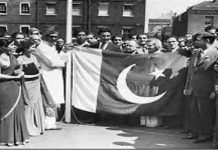Peshawar: The 322 ft. high concrete faced rock fill Kurram Tangi Dam construction has been facing delays since 2013. The flow from the dam would irrigate 325,000 acres of land through a comprehensive canal system and produce 83 Mega watts (MW) through 5 powerhouses.
Malik Saddar Khan raises a trembling finger as he swears to never allow anybody to build the dam. His speech is irregular with anger and emotion as the 75 year old tribal elder, better known as Sadarka Haji, tells the protesting tribesmen in a park in Peshawar that even the government won’t be allowed to construct the dam.
Haji and other tribesmen from North Waziristan Agency (NWA) have gathered in the park Bagh-e-Naran in Peshawar to protest the government’s decision to build the Kurram Tangi Dam in NWA. Haji is from the Kabul Khel tribe on whose lands the proposed dam would be built. There are close to 60 tribal elders and students here. The protest is led by Malik Faridullah Khan Wazir, leader of the Kabul Khel tribe.
“The dam will be built on lands where the bones of our forefathers are buried,” Haji told News Lens. “We cannot allow that.”
According to the Water and Power Development Authority (WAPDA), the project site for Kurram Tangi Dam is located across River Kurram in NWA. It is about 9 miles upstream of Kurram Garhi Headworks and 19 miles North of Bannu city in the Federally Administrated Tribal Area (FATA).
When built, the dam will produce electricity of about 83.4 megawatts. Its proposed height is 322 ft., with a gross storage capacity of 1.20 Million Acre Feet (MAF). The dam, whose reservoir will cover 10,939 acres, will store water for irrigation and power generation. It will irrigate an area of 84380 acres including Sheratala plain in NWA, Spera Rogha Plain in NWA, the Thal plain and districts of Karak and Lakki Marwat.
The project has been delayed since 1936 when it was first proposed by the British government. Even back then, says Malik Faridullah, their tribal ancestors opposed the project.
“They went into self-exile in Afghanistan as to show their resentment against the construction of the dam,” says Faridullah, adding, “How can we now agree with rulers bent on displacing us from our ancestral lands? We will not allow it at any cost.”
The tribesmen have responded with a wave of protests to an announcement by the government in December 2016 that the first phase of the dam would be inaugurated by the Prime Minister Nawaz Sharif soon. USAID would provide $81m for Kurram Tangi Dam, according to an agreement signed in December between the Ministry of Water and Power and the US international development agency.
“The feasibility study, detailed engineering design and tender documents of the project were completed as far back as March, 2005, said Kamran Khan Afridi, Political Agent North Waziristan Agency. The project was redesigned in July 2007 with an increased height to enhance the storage capacity. Afridi said WAPDA had secured financing of Stage-I (Kaitu Weir and Irrigation and Power Project) of Kurram Tangi Dam Project through USAID.
But Afridi criticized WAPDA for what he called was its “sluggish behavior” towards completion of the project.
“They were showing indifference towards the project and the entire burden of making up ground for the project locally is on the shoulders of the political administration,” said Afridi. “WAPDA should come up with a solid plan to motivate the tribesmen concerned about the dam but it doesn’t.”
He said this was not the first time that the Kurram Tangi Dam (KTD) had created tension between the officials and the tribesmen of Kabul Khel. The issue had been raised time and again, he said, only to go into cold storage, without its proper resolution once and for all.
The dam’s construction has provoked rage among the Kabul Khel tribe but tribal elders from across North Waziristan Agency have joined hands with them to protest the project at the “cost of Kabul Khel ancestral lands.”
Malik Ghulam Khan, a tribal elder and a former president of Waziristan Political Alliance from Madakhel tribe in NWA, is among those who are vocal opponents of the project.
“We call it Zarb-e-Water or Zarb-e-Drowning [an allusion to Zarb-e-Azb – a cutting strike – the military operation in NWA started to clear the tribal district of militants there]” Khan told Truth Tracker. “We vacated the entire area of people [for the military operation that reportedly displaced a million people from NWA] to safeguard the country against militants holed up here. But now there are no more threats to the state. Why would it want to force us to leave the area with our bags and baggage again [displacement due to the dam]?”
Another tribal elder Abdul Khalil said the tribes would go to any length if the government chose to use force for the construction of dam. “The authorities should first come and make an agreement with the Kabul Khel tribe,” said Khalil. “If they agree on building the dam, we will have no objection. But if the tribe disagrees, the entire Waziristan would back the Kabul Khel,” he said.
A student union leader Allaudin Khan from NWA said they would be part of the protests led by the tribal elders wherever they are held. He also blamed the USAID for funding the project when no steps had been taken to take into confidence the local community. “Projects of this magnitude and impact cannot be built without the consent of the local community and as far as I know we have not been consulted by anybody,” said Khan.
The Political Agent of NWA, Kamran Khan Afridi, said the dam would not affect the tribal population, as it would be built in the hills of Waziristan and some of the land. But students fear they would lose lands and shelter and would be displaced like the community in case of Turbela Dam.
“We have been cautioned by those affected by the Turbela Dam not to allow the government to start work on the dam,” Allaudin said. He said the government should first construct the controversial Kalabagh Dam if possible. “Kalabagh is opposed by a single political party [Awami National Party] while Kurram Tangi is an issue of life and death for the entire Kabul Khel tribe with a population more than 300,000,” he said.
The tribesmen said the project would benefit parts of Lakki Marwat and Karak districts while destroying the ancestral lands of Kabul Khel. “We cannot destroy our homes to save the homes of our neighbors,” said Malik Faridullah. The dam would also damage parts of the Bannu city, he added.
The construction of Kurram Tangi has been delayed from time to time. The tribesmen say the project is being pushed for political point scoring by some of the politicians.
“The formal federal minister Naveed Qamar once told the Senate that work on the dam was in full swing when it has not even been inaugurated,” said Abdul Qadir, grandson of Shewa Faqeer, a spiritual leader of Shewa.
About the delay in dam’s construction, Political Agent Kamran Afridi said there were multiple factors responsible for it. “Lack of funds, lack of expertise and lack of interest on part of the government are some of factors that has delayed this useful project,” said Afridi.
He said Pakistan now had engineers and the FWO (Frontier Works Organization – a building and construction subsidiary of the Pak Army) and the project would be finally realized. However, Afridi didn’t detail the construction site information and neither commented on his plan to bring the locals on board.



